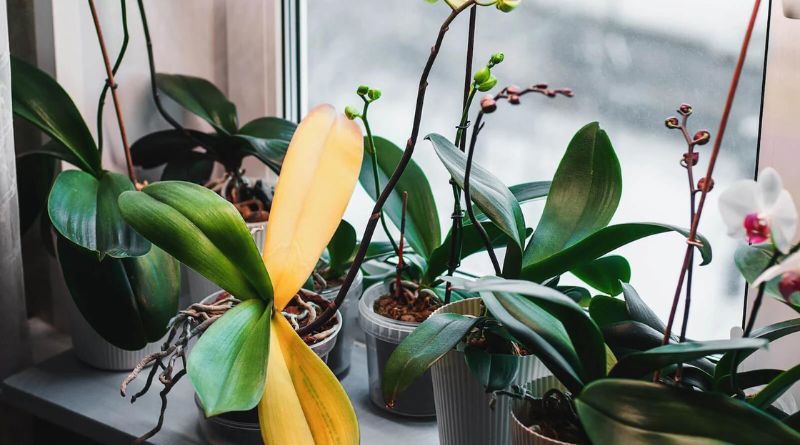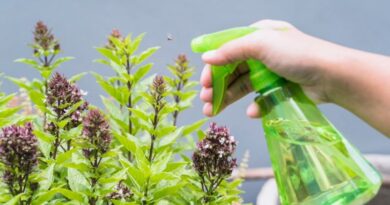Reasons Orchid Leaves Turn Yellow – Orchids, revered for their exquisite beauty, often captivate enthusiasts with their vibrant blooms and graceful foliage. However, the disheartening sight of yellowing leaves can signal distress within these delicate plants. Understanding the myriad reasons behind this phenomenon is crucial for orchid enthusiasts seeking to cultivate thriving specimens.
Yellowing leaves may stem from environmental factors such as inadequate light, temperature fluctuations, and humidity imbalances. Watering issues, including both overhydration and underwatering, can contribute to this disconcerting change. Furthermore, nutritional deficiencies, pest invasions, diseases, and root-related problems may all play roles in the discoloration of orchid leaves.
This exploration delves into these factors, providing insights into the nuanced care required to maintain the resplendent allure of healthy orchids. As stewards of these botanical wonders, enthusiasts are encouraged to navigate the intricate dance of environmental conditions, nutrition, and vigilant care to ensure the longevity and vibrancy of their cherished orchid specimens.
Reasons Orchid Leaves Turn Yellow
Overwatering
Overwatering orchids leads to yellowing leaves due to root rot. Excessive moisture in the growing medium deprives roots of oxygen, impairing nutrient uptake. To prevent overwatering, allow the top inch of the orchid’s growing medium to dry before watering again.
Ensure proper drainage in the pot and use a well-aerated orchid mix. Adjust watering frequency based on the plant’s specific needs and environmental conditions. Yellowing leaves can signal waterlogged roots, prompting a reduction in watering frequency to restore root health.
Also, Read – Valuable Items to Preserve Instead of Discarding
Underwatering
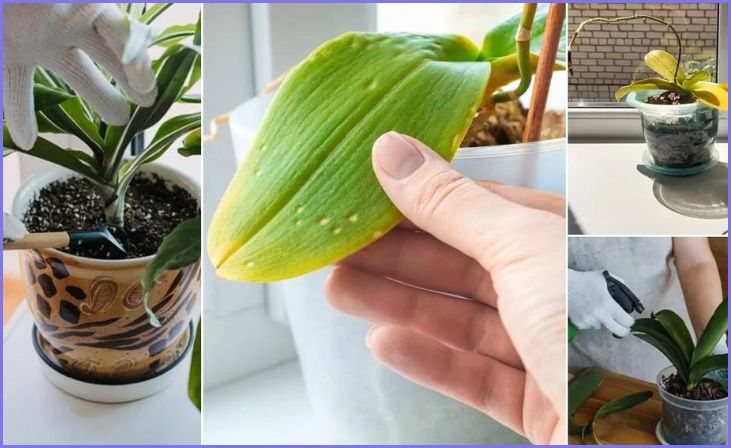
Underwatering causes orchid leaves to yellow as the plants lack sufficient moisture for optimal growth. Inadequate water supply hampers nutrient absorption and leads to dehydration. To address underwatering, ensure a regular watering schedule, allowing the top inch of the growing medium to dry between waterings.
Adjust the frequency based on environmental conditions and the orchid’s specific needs. Consider factors like humidity and temperature that affect water requirements. Yellowing leaves may indicate the need for increased watering, promoting healthier growth and preventing dehydration-related stress.
Improper Light
Yellowing orchid leaves may result from improper light conditions. Orchids generally thrive in bright, indirect light. Insufficient light can lead to reduced photosynthesis, impacting leaf health. Conversely, excessive light may cause leaf burns and yellowing.
Assess the orchid’s location and adjust light exposure accordingly. Provide filtered or dappled sunlight to prevent direct exposure. If leaves are yellowing, consider relocating the orchid to a spot with better-suited light levels. Regularly monitor light conditions and maintain a balance to support optimal orchid growth.
Improper Light
Yellowing orchid leaves may stem from improper light. Orchids thrive in bright, indirect light, but inadequate or excessive light can cause issues. Insufficient light hampers photosynthesis, leading to yellowing. On the other hand, too much light may scorch leaves.
Evaluate your orchid’s location and adjust light exposure accordingly. Provide filtered or shaded sunlight to prevent direct rays. If leaves turn yellow, consider relocating the orchid to an area with suitable light levels. Regularly assess and adapt to maintain the right balance for healthy orchid growth.
Also, Read – Plants to Transform Your Garden
Nutrient Deficiency
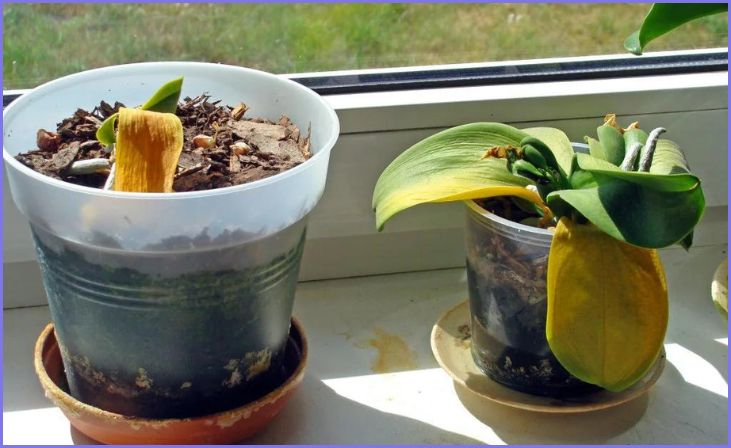
Yellowing orchid leaves may signal nutrient deficiency, commonly a lack of nitrogen. Orchids require balanced nutrients for optimal growth. Use a specialized orchid fertilizer with a balanced formulation to address deficiencies. Apply the fertilizer according to package instructions, typically during the growing season.
Regularly monitor the plant’s overall health and adjust the fertilization regimen as needed. Ensure proper dilution to avoid over-fertilization, which can harm orchids. Providing the right nutrients promotes vibrant foliage and robust flowering in orchids.
Root Issues
Yellowing orchid leaves can result from root issues such as decay or damage. Healthy roots are crucial for nutrient absorption. Check the roots for signs of rot, discoloration, or mushiness, especially in the absence of new growth.
Repot the orchid if you observe compromised roots, trimming away damaged parts and using fresh orchid mix.
Ensure proper drainage in the pot to prevent waterlogged conditions that lead to root problems. Healthy roots contribute to overall orchid well-being, and addressing root issues can help restore the plant’s vitality and prevent further leaf yellowing.
Disease and Pests
Yellowing orchid leaves may indicate the presence of diseases or pests. Inspect the plant for signs of common orchid pests such as spider mites, scale, or fungal infections. Treat infestations promptly with appropriate insecticides or fungicides, following product instructions. Isolate infected orchids to prevent the spread of diseases.
Maintain good orchid hygiene by regularly cleaning leaves and removing debris. Proper ventilation can deter certain pests. Vigilance and quick intervention are key to preserving orchid health, ensuring vibrant foliage, and preventing yellowing caused by diseases or pests.
Environmental Changes
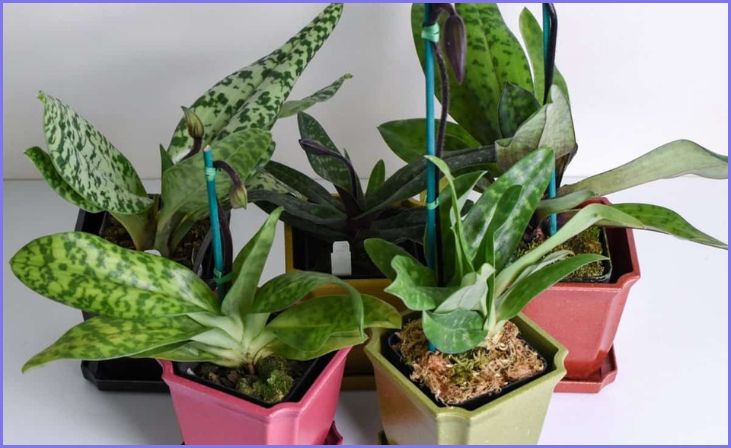
Sudden environmental changes can lead to yellowing orchid leaves. Orchids are sensitive to fluctuations in temperature, humidity, and air circulation. Gradually acclimate them to new conditions to minimize stress. Ensure a stable environment within their preferred temperature and humidity range.
Protect orchids from drafts and temperature extremes. Adjust watering frequency and light exposure when moving orchids to new locations. Consistent care promotes leaf health and prevents yellowing due to environmental stress. Monitor and maintain a stable growing environment to support the well-being of your orchids.
Old Age
Yellowing lower or older leaves in orchids can be a natural part of the plant’s life cycle. As leaves age, they naturally yellow and eventually wither. This process is normal, and older leaves will naturally drop off. Focus on the overall health of the plant, including the condition of newer leaves and the presence of new growth.
If yellowing occurs primarily in older leaves and the rest of the plant appears healthy, it is likely a result of the natural aging process. Regularly remove spent or yellowing leaves to encourage energy allocation to new growth.
Conclusion
In conclusion, preserving the vitality of orchids necessitates a holistic approach encompassing attentive environmental management, precise watering practices, and vigilant pest control. Orchid enthusiasts should prioritize regular monitoring, swift responses to signs of distress, and adherence to best care practices.
By fostering a balance of light, moisture, and nutrients, and addressing potential stressors promptly, one can safeguard the radiant beauty of orchids. Ultimately, a conscientious commitment to comprehensive care will reward cultivators with the enduring splendor of these botanical treasures.
FAQs
Look for elongated and weak growth, as well as dark green leaves. If your orchid isn’t blooming, it may also be an indicator of insufficient light.
Orchids generally thrive in humidity levels between 50% and 70%. Low humidity can contribute to yellowing, especially in environments with inadequate moisture.
Orchids prefer a balanced watering routine. Allow the top layer of the growing medium to dry before watering, and avoid overwatering, which can lead to root rot.

